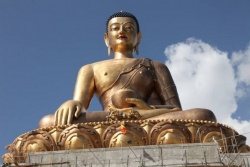Dpal Idan bkra shis
Dpal ldan bkra shis
Dpal ldan bkra shis (Chinese – Bandan zhashi, 1376-14--?) was a significant figure in Ming imperial interactions with Tibet through patronage of Tibetan Buddhism. He was a key participant in Beijing’s Buddhist activities during his tenure there, and was influential in the National Buddhist Registry (Senglusi). By way of example of his work in Beijing, Dpal ldan bkra shis is recorded to have translated Tibetan Buddhist texts into Chinese, acted as translator for the Fifth Karmapa, and ordained Ming officials. Under imperial order, the Huguosi temple was rebuilt as his personal residence in 1435 and a portrait statue of him was installed in perpetuity. Additionally, he was one of three clerics acknowledged in Fahaisi temple inscriptions as having played a critical role in the founding of this imperially sponsored Beijing temple. Fahaisi is located on Mt Cuiwei in the Shijingshan district of Beijing and bears typical marks of both Chinese and Tibetan iconography, making it useful for art historical investigations of “Sino-Tibetan” aesthetics. Dpal ldan bkra shis was given the title Jingjue ciji daguoshi or “Purely Enlightened Compassionately Helpful Great State Preceptor.”
Outside Beijing Dpal ldan bkra shis was instrumental in the construction and management of two imperially sponsored provincially located temples that served notably strategic political functions as well as religious ones. These were Qutansi in Qinghai (founded 1392), where he was abbot, and Lhun grub bde chen gling in Gansu, which he founded. Qutansi was originally a Bka’ brgyud temple with close ties to the Sa skya until Dge lugs pas became dominant there in the mid-16th century. It is located at the border of the Northwest Ming frontier and the Eastern edge of Amdo and its abbots were key figures in the Ming imperial courts’ interactions with Tibet. As the seat of the Xining Prefectural Buddhist Registry ((Xining Senggangsi) Qutansi’s abbots had jurisdiction over 13 other temples and their estates. The Yongle emperor named Dpal ldan bkra shis abbot in 1408. Artistically, the temple’s exterior is distinctively Chinese, while the interior shows more Tibetan influence in terms of iconography and style.
Dpal ldan bkra shis founded Lhun grub bde chen gling (Longzhu deqinglin, formerly Da Chongjiaosi) in Minzhou, Gansu in 1428. Like the temples mentioned above, this temple exhibits objects and images of both Chinese and Tibetan styles. Dpal ldan bkra shis’s biography records that the imperial patronage of the project included the appointment of two high ministers, one hundred civil officials, 200 district officials, 1, 100 artisans, and 25,000 military corvee laborers. Thus it seems to have been the site of major imperial interest and attention, apparently due in large part to its strategic location.
Dpal ldan bkra shis’s fundamental involvement in these three temples is a key indicator of his role in the Ming imperial courts’ interfacing with Tibet/Tibetan Buddhism.
Source:
Debreczeny, Karl. “Sino-Tibetan Artistic Synthesis in Ming Dynasty Temples at the Core and the Periphery”
Entry by Dominique Townsend
